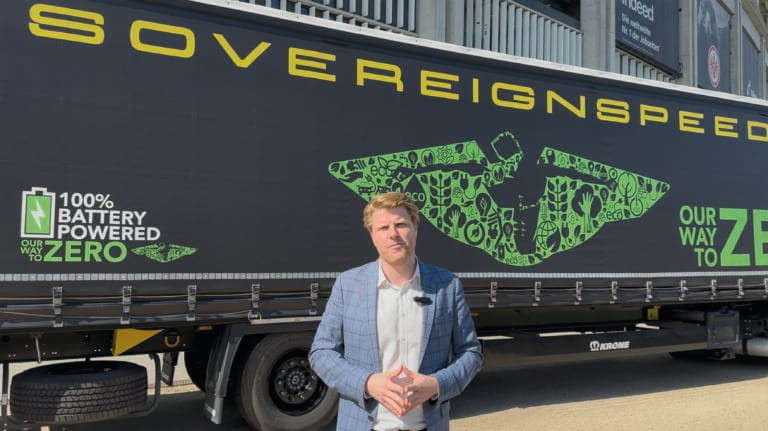- Road feeder services remain a vital but often unseen component of Europe’s logistics network, linking airports overnight and supporting time-sensitive sectors such as pharmaceuticals, aerospace, and high-value e-commerce.
- By shifting cargo from short-haul flights to trucks, operators can reduce emissions by up to 50 percent on international lanes, while investment in electric fleets, infrastructure, and long-term sustainable practices ensures reliability for clients over the next decade.
- Success in decarbonising logistics depends on collaboration across the supply chain, integrating technology, digital tracking, and data transparency so clients can monitor emissions reductions and demonstrate compliance with regulatory and sustainability expectations.
For decades, road feeder services have played a quiet but crucial role in Europe’s logistics ecosystem. Operating largely at night, fleets of trucks link airports across the continent, ensuring cargo arrives in step with early morning flights. While airfreight remains essential for time-critical shipments, especially in industries such as pharmaceuticals and aerospace, the carbon footprint of short-haul flights has prompted calls for alternatives.
By shifting cargo from intra-European flights to trucks operating overnight routes, emissions can be cut dramatically. “Already today, we see reductions of around 50 percent on international lanes by just using the road network instead of airfreight,” explains Moritz Toelke, who leads the decarbonisation strategy at Sovereign.
“Sustainability can only be thought long term,” he says. “It very much fits to our general practice to not go for quick gains, but to build sustainable business models.”
This approach shapes both investment decisions and customer relationships. “We are heavily investing into our own electric fleets, our own infrastructure, to really build that forward,” he explains. “And that’s also what we need our clients to do. The projects we take and the verticals we serve — typically air cargo, aerospace and pharma — are industries that value long-term reliability over short-term costs.”
These sectors, Toelke argues, are natural partners for a green transition. “They have goods which are very sensitive, very high value, and they put quality first. They want a reliable solution for the next five or ten years. And those clients are the ones supporting our path to zero-emission solutions.”
By focusing on steady, structural changes rather than headline-grabbing initiatives, the sector aims to embed sustainability into its core operations. “It’s about building networks that can endure, that are resilient, and that are ready for the challenges of tomorrow,” he says.
Collaboration across the supply chain
No single operator can decarbonise logistics in isolation. The interconnected nature of airfreight and road feeder services means cooperation across the supply chain is critical. Success won’t come from one company installing charging stations or trialling new fuels. It will depend on a collaborative effort across multiple industries and sectors, aligning regulation, investment and customer demand.
“It’s teamwork that is key,” Toelke stresses. “Everybody is in the same seat in this sense. We have the trucks, so we are polluting on behalf of our clients, and they in turn are working on behalf of shippers and end customers. Responsibility runs through the whole chain.
“We are an alternative to airfreight in many cases, but the real challenge is building solutions that are green, reliable, and future-proof. That requires everyone to pull in the same direction.”
That means solutions need to be built together. “We can be ready for electric trucks, we can be ready for biodiesel solutions,” he says. “Airlines can be ready for sustainable aviation fuel. But it needs the clients to support that process — to help overcome hurdles like infrastructure. Only then can these steps be multiplied across the system.”
The shift requires a new mindset, moving from transactional procurement to what Toelke calls a “transformational approach”. “We also now need to talk to governments, to energy grid providers, to players who weren’t traditionally part of logistics. To build a truly sustainable future, far more actors need to be involved.”
Drivers of efficiency
Technology, too, is emerging as a powerful ally in the push for greener logistics. “In our strategy, our way to zero, we focus on measure, reduce, avoid,” Toelke explains. “And digitalisation is crucial at every step.”
The first benefit lies in optimisation. “There are so many tools available to reduce fuel consumption and increase efficiency,” he says. “We have telematics on every truck, we use transport management systems to optimise routes. These digital solutions help us understand where and how we are consuming, and how that can be reduced.”
But technology is not just about better routing. Transparency is equally vital. “It’s great if we bring in electric trucks or alternative fuels,” Toelke says. “But if that information isn’t linked to the shipment, if our clients don’t see the CO2 reductions represented in their systems, then it doesn’t count. That’s why we need data transparency and API connections — so customers can measure, report and demonstrate their progress.”
For clients under increasing regulatory and consumer pressure to show emissions reductions across their supply chains, such visibility is no longer optional. It has become a requirement. “Technology is not just an instrument to reduce fuel,” Toelke concludes. “It’s also a supporter for transparency. Without it, you can’t monitor or prove the transition.”





